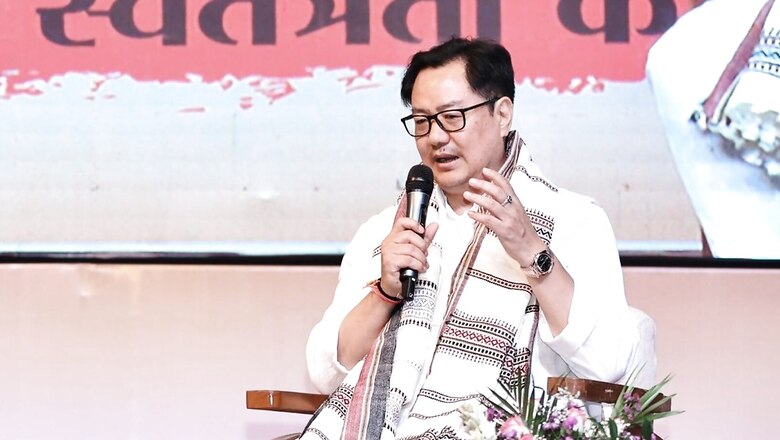
views
Union Minister for Law and Justice Kiren Rijiju on Saturday expressed his views on the much-debated issue concerning the appointment of judges in the higher judiciary.
Speaking to Livelaw against the collegium system of appointing judges, Rijiju was of the opinion that if Judges are involved in identifying the next judges, it will definitely have an adverse impact on their duty as a judge.
Backing his statement, he further said that the collegium system has taken away the precious time of the judges of the High and supreme courts by getting them involved in an administrative jobs.
Notably, this comes at a time when the Apex Court and the Centre are at odds over how judges should be appointed.
While the government has been stressing on the need for a National Judicial Appointments Commission (NJAC), the Supreme Court has been relentlessly defending the present Collegium system.
But what are the two systems for the appointment of judges, and what triggered the debate? Here’s a look at it
The Collegium versus NJAC debate was reignited in November of last year when Union Minister Rijiju commented that the Collegium system of appointments was ‘opaque’ and needed to be reconsidered.
Calling the act of striking down NJAC by the SC in 2015, a disregard of the mandate of the people, Rijiju said that it’s never too late to introduce the said act in place of the collegium system which did not reflect the feelings of the people and the house.
He also pinned the blame for the huge pendency of cases in courts on the collegium system and said that the matter can only be resolved if the collegium system is struck down.
What is the Present Collegium System?
In this system of appointment, the Chief Justice of India along with four senior-most Supreme Court judges recommend appointments and transfers of judges.
A High Court Collegium is led by the incumbent Chief Justice and the two seniormost judges of that court.
The government’s role in this is however limited to getting an inquiry conducted by the Intelligence Bureau (IB) if a lawyer is to be elevated as a judge in a High Court or the Supreme Court. The government can also raise objections and seek clarifications regarding the Collegium’s choices, but, if the Collegium reiterates the same names, the government is bound, under Constitution Bench judgments, to appoint them to the post.
The critics however note that the problem in this system lies in the fact that it lacks transparency since it does not involve a mechanism, neither it is known when the collegium meets and takes decisions.
A look into the NJAC System of Appointment
The NJAC Act was passed by Parliament in 2014 to set up a commission for appointing judges, replacing the Collegium system which was meant to Increase the government’s role in the appointment of judges.
The NJAC was to comprise the Chief Justice of India as the ex officio Chairperson, two senior-most Supreme Court Judges as ex officio members, the Union Minister of Law and Justice as ex officio member, and two eminent persons from civil society — one of whom would be nominated by a committee consisting of the CJI, Prime Minster and the Leader of Opposition in the Lok Sabha, and the other would be nominated from the SC/ST/OBC/minority communities or women.
The judiciary representatives in the NJAC, the Chief Justice, and two senior-most judges can veto any name proposed for appointment to a judicial post if they do not approve of it. Once a proposal is vetoed, it cannot be revived. At the same time, the judges require the support of other members of the commission to get a name through.
Read all the Latest India News here


















Comments
0 comment